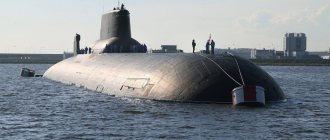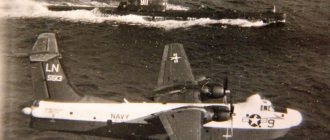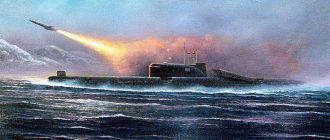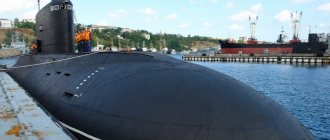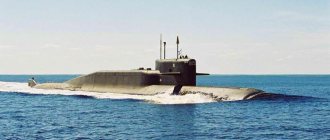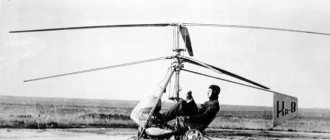Strategic submarines usually attract the attention of the public. This is understandable - the realization that the submarine carries dozens of powerful nuclear warheads cannot help but impress. And the role of underwater “rocket launch sites” in maintaining the “nuclear shield” has always been emphasized.
However, in the Soviet and then Russian submarine fleet, an equally significant role was played by Project 949A Antey submarines - a kind of analogue of surface missile cruisers. They were the underwater “aircraft carrier killers”, capable of destroying an entire strike group. They remain a counterweight to these groups even now.
History of creation
The development of third-generation Soviet nuclear submarines began in 1969 after a government decree on the adoption of a warship construction program. It was planned to develop an underwater strategic missile carrier, a multi-purpose attack submarine and a submarine armed with anti-ship cruise missiles. It is the latter idea that will be embodied in the form of Project 949 submarines.
The new generation submarines were initially subject to strict requirements to reduce visibility, and if previously they tried to achieve this by increasing the diving depth, now the approach has changed. The new nuclear submarines were to become invisible due to their low noise level. Project 949 Granit submarines, designed at the Rubin design bureau, turned out to be the first third-generation nuclear submarines in terms of creation. This forced the designers of other boats to unify their designs with the 949.
The terms of reference envisaged the creation of a submarine capable of independently finding enemy aircraft carrier groups, monitoring them, and also being able to destroy enemy ships with a missile salvo, and then escape using high speed and silence. In order for the submarine cruiser to be able to perform such a task, heavy cruise missiles P-700 began to be developed especially for it, named, like the nuclear submarine project, “Granit”.
The considerable dimensions of the future missile, as well as the need to place a large number of launchers on the submarine, determined the dimensions and displacement of the future cruiser.
Since it turned out that only a plant in Severodvinsk (SMP) could build such a large submarine, the designers also prepared a version of the project with “limited capabilities”, the construction of which could be deployed at other shipyards. But they still approved the main option. The lead ship, K-525, was laid down in 1975, and the second, K-206, in 1979.
They became the only Project 949 Granit submarines. This did not mean abandonment of construction - simply the remaining planned ships were built according to an improved design, called “949A Antey”. They were distinguished by an elongated body (added 10 meters in length), in which an additional compartment appeared. Due to this, we were able to better place the internal mechanisms. In addition, the noise level was further reduced. The first Antey was laid down in 1982, it received the designation K-148.
APL 949 device
Submarines of the Antey type have a double-hull design: a lightweight outer hydrodynamic cylindrical hull surrounds an inner one, which differs from the outer one in its high strength. The thickness of its walls exceeds 6 cm. Due to this double-hull architecture, nuclear submarines have the following advantages:
- Submarines are provided with high buoyancy.
- Nuclear submarines are protected from underwater explosions.
- Submarines have increased displacement.
The hull of nuclear submarines consists of the following departments:
- Torpedo.
- Managerial.
- Compartments for combat posts and radio room.
- Residential premises.
- Department for electrical equipment and auxiliary mechanisms.
- Reactor.
- GTZA Department.
- Compartment with rowing electric motors.
In the event of an accident, a nuclear submarine is equipped with two zones (bow and stern) in which the crew can wait for rescue. The crew consists of 130 people. According to other data, the number does not exceed 112. The submarine can remain in autonomous mode for no more than 120 days.
Design
The robust housing is cylindrical in shape and made of steel. Bulkheads divide it into nine (on submarines of the Granit project) or ten (on Anteev) compartments. On the sides, between the light and durable hulls, launchers of Granit anti-ship missiles are placed.
Due to this arrangement of weapons, the light hull received a characteristic “flattened” shape, for which the boat was nicknamed “loaf”.
The “superstructure” fence covers the navigation bridge, retractable devices (periscopes, etc.) and air supply systems to diesel generators and ventilation.
In the bow compartment there are torpedo weapons and batteries. The next two compartments contain the central post, other combat posts, and the radio room. These compartments also serve to accommodate batteries. The fourth compartment is residential, the fifth contains auxiliary mechanisms. The additional compartment that appeared on Project 949A also contains auxiliary units.
The reactor compartment is the seventh; behind it, steam turbines are located in separate compartments. The aft compartment is for electromechanics. The basis of the cruiser's power plant is two OK-650M pressurized water reactors and two steam turbines, which rotate two fixed-pitch propellers through gearboxes.
Inside the submarine's retractable device enclosure is a pop-up escape capsule. With its help, you can evacuate the entire crew from the submarine, even if the boat is at extreme depth.
An emergency rescue hatch is provided in the bow rescue area, through which you can exit while wearing rescue equipment. The hatch in the aft rescue area is additionally equipped with a platform for landing rescue vehicles. The B-600 pop-up buoys, which can be separated from the hull automatically, should notify about an accident.
There were differences not only between the Granit and Antey, but also between the individual ships of the projects. This was due to the fact that the projects were continuously modernized, counting on the gradual introduction of mechanisms and design solutions that had not yet been developed and thought out. Thus, a place for installing a towed Pelamida antenna appeared on the K-206, and the first cruiser to actually receive this antenna was the K-148.
K-173 (the second Antey) received new launchers that could be used to launch advanced missiles, which also reduced the weight of the missile systems by 60 tons.
A new sonar system was installed on the K-132 submarine, and the K-119 received a new periscope and a different system for purging surge tanks.
Submarine combat control
The Antey nuclear submarine is equipped with MGK-540 Skat-3 sonar systems and systems that provide space reconnaissance, target designation and combat control of the submarine. Information received by a satellite or aircraft is transmitted to the submarine using special antennas. Additionally, Antey-class submarines are equipped with a towed Zubatka antenna.
Its location is the stern stabilizer. The buoy-type antenna “Zubatka” is intended for receiving radio messages and signals by a boat located at very great depths or under a thick layer of ice.
Navigation in the submarine is provided by the special Symphony-U complex. High accuracy, long range and volume of processed information are the characteristic features of this navigation system.
Armament
The Anteev's main weapon, the Granit cruise missiles, needs no further introduction. Suffice it to say that the only surface ships capable of using them were heavy cruisers of the Orlan class, and there were four fewer missiles there than on submarine cruisers.
The launch of all 24 missiles in one salvo, according to the designers’ calculations, would make it possible to break through any missile defense, and the ability of the missiles to exchange data with each other made it possible to optimally distribute targets “independently.” Missiles are launched from under water. To guide the P-700 to targets at maximum range, data was used either from Tu-95RTs aircraft or from the Liana satellite reconnaissance system.
The later boats of the series were supposed to be armed with promising Bolid missiles, and those already built were supposed to be re-equipped with them during repairs. However, in the 90s, the construction of the laid down boats was frozen, and work on the “Bolide” theme was closed. But the scheme for re-equipping the Anteys with Onyx and Caliber missiles, developed at the same time, was implemented already in the next century.
Since 2013, the K-123 Irkutsk submarine has been modernized, and it is expected that during the repair of the K-442 Chelyabinsk submarine, it will also be re-equipped.
In the future, the re-equipped boats will be able to use the latest Zircon missiles.
Through two 650mm torpedo tubes, the cruisers of the Antey project could launch 65-76 torpedoes. These 4-ton torpedoes could reach speeds of up to 70 knots (according to some sources), and their warhead contained more than half a ton of explosive. The ammunition capacity was eight torpedoes, on some boats - 12. Torpedoes 65-76 were removed from service after the death of the Kursk submarine, coming to the conclusion that the disaster occurred due to the explosion of the warhead of this type of weapon.
Four 533mm torpedo tubes are used to launch USET-80 homing electric torpedoes. They develop up to 45 knots and contain a warhead weighing up to 300 kg.
Through 533mm devices it is also possible to launch the Vodopad and Shkval rocket-torpedoes, which, using a hydrojet engine and movement in a steam bubble, develop a marching speed of 375 km/h.
For self-defense against aircraft, the Antey crew, which is on the surface, uses the Igla man-portable anti-aircraft missile system; there are 16 such missiles on board.
What are the submarines armed with?
The armament of the Antey-class nuclear submarines is represented by two types:
- Anti-ship missiles (ASM) P-700 “Granit” (24 units). The location of the missile containers was on both sides of the wheelhouse behind the wall of the pressure hull (the middle part of the submarine). To close them, special fairing covers are used, which are part of the outer casing. The container is installed at an angle of 40 degrees. The missiles can be used both conventional (weighing up to 750 kg) and equipped with nuclear warheads. PRKs move at a speed of 2.5 m/s and are designed for distances of up to 550 km.
- Mine-torpedo tubes (four pieces). Two of them have a caliber of 533 mm, the rest - 650 mm. They are designed to fire both conventional torpedoes and torpedo missiles. The location of these devices was the bow of the nuclear submarine. Due to the system responsible for automatic loading, the torpedo weapon has a high rate of fire. In just a few minutes, the entire ammunition load, consisting of missile torpedoes (12 units) and torpedoes (16 units), can be fired by the Antey submarine.
Performance characteristics
Despite the fact that the expression “has no analogues” is often used in an ironic way, there is no other way to say about the submarines of the Antey project. The generation of American submarines that appeared in the same years included two types of ships - the Ohio strategic missile carriers and the Los Angeles multi-purpose attack boats.
Submarine cruisers capable of independently destroying Soviet squadrons were simply not developed. On the other hand, in the 2000s, the oldest boats of the Ohio class were converted into carriers of Tomahawk cruise missiles, becoming a fairly close analogue of the Anteys, rearmed with Onyx missiles.
| Project 949AM | Ohio class SSGN | |
| Displacement, tons | 14700/24000 | 16764/18750 |
| Length, meters | 154 | 170 |
| Width, meters | 18 | 13 |
| Speed, knots | 32 | 25 |
| Crew, man | 130 | 155 |
| Armament | 2 torpedo tubes of 650mm caliber, 4 torpedo tubes of 533mm caliber, 72 Onyx missiles | 4 torpedo tubes of 533mm caliber, 154 Tomahawk missiles |
It is clear that it was possible to place more cruise missiles in the Trident ballistic missile silos than in the Granit site. At the same time, the American submarine has retained a relatively low speed and is inferior to the Antey in terms of diving depth. Still, the carrier of strategic missiles did not need to quietly monitor the ships and quickly evade pursuit. And even when shelling coastal and ground targets, these qualities will not be decisive.
They don’t demand anything more from old boats - as long as they serve out their term. But the re-armed Antey must retain the capabilities of countering fleet strike groups, and how high they will be is unknown.
Exploitation
During the 80s, six Anteys and two boats built according to the original design were transferred to the fleet. From 1992 to 1996, six more submarines were completed and put into operation. All of them served in the Northern and Pacific fleets. In the nineties, cruisers received their own names in addition to alphanumeric indices.
Boats were named after cities.
Although maintaining the submarines in combat-ready condition was declared a priority, the critical state of the state's economy forced the oldest ones to be written off as new Anteys were completed. By the end of the decade, Arkhangelsk and Murmansk, the Granit project boats, were decommissioned. Behind them, the first Anteis, Krasnodar and Krasnoyarsk, left the fleet lists. The “oldest” cruiser remains the Irkutsk, laid down in 1985 and commissioned in 1988.
“Anthea” became widely known in 2000, but under such circumstances that it would have been better not to have received it. The newest Project 949A boat of the Northern Fleet, the Kursk, was lost along with its entire crew during the exercise. At the same time, the warning buoys did not work, and the sailors were unable to use the means of rescue.
Three boats, the construction of which was suspended, were in a fairly high degree of readiness by the beginning of the 2000s. Two of them were finally abandoned in 2012, and they were dismantled for metal. But they decided to re-mortgage the Belgorod boat and complete it according to a special project. It will become the carrier of deep-sea vehicles. The remaining eight Anteys, contrary to pessimistic forecasts, were successfully repaired and are either in combat service or being modernized.
Although Project 949A submarines were developed back in the 70s, they still remain a formidable weapon.
This is best evidenced by the fact that it was them, unlike the surface cruisers of Project 1144, that they tried with all their might to preserve in the difficult nineties. All the Orlans then went into reserve, but the Anteis remained in service and were being completed.
The high combat qualities and enormous firepower of the submarine cruiser are not in doubt. Analysts doubt something else - was the Antey, a huge, expensive and rather highly specialized boat, a dead-end branch of development? It is possible that the Americans were right when they relied on relatively cheap and mass-produced multi-purpose boats. But for their time, Project 949A submarines were certainly relevant and necessary. And their time may not have passed yet.

